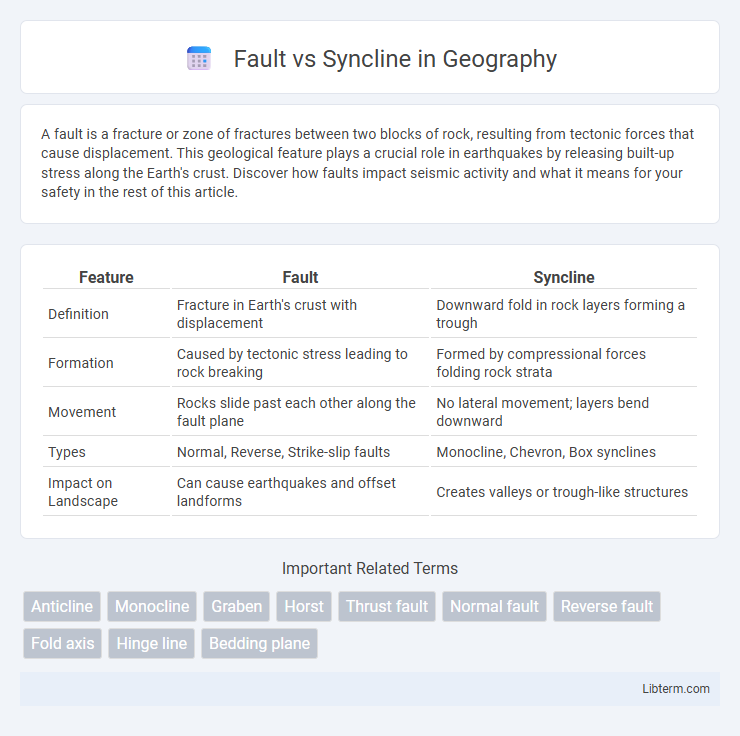A fault is a fracture or zone of fractures between two blocks of rock, resulting from tectonic forces that cause displacement. This geological feature plays a crucial role in earthquakes by releasing built-up stress along the Earth's crust. Discover how faults impact seismic activity and what it means for your safety in the rest of this article.
Table of Comparison
| Feature | Fault | Syncline |
|---|---|---|
| Definition | Fracture in Earth's crust with displacement | Downward fold in rock layers forming a trough |
| Formation | Caused by tectonic stress leading to rock breaking | Formed by compressional forces folding rock strata |
| Movement | Rocks slide past each other along the fault plane | No lateral movement; layers bend downward |
| Types | Normal, Reverse, Strike-slip faults | Monocline, Chevron, Box synclines |
| Impact on Landscape | Can cause earthquakes and offset landforms | Creates valleys or trough-like structures |
Introduction to Faults and Synclines
Faults are fractures in the Earth's crust along which displacement has occurred, often caused by tectonic stress, leading to significant shifts in rock layers. Synclines are downward-curving folds in sedimentary strata where the youngest rock layers are at the core, typically formed by compressional forces. Understanding the structural differences between faults and synclines is crucial in geology for interpreting Earth's tectonic history and assessing seismic risk.
Defining Faults: Types and Characteristics
Faults are fractures in the Earth's crust where significant displacement has occurred due to tectonic forces, categorized into normal, reverse, and strike-slip types based on the movement direction. Normal faults result from extensional stress causing the hanging wall to move down, while reverse faults form under compressional forces pushing the hanging wall upward. Strike-slip faults exhibit lateral motion with blocks sliding past each other, often linked to transform plate boundaries and seismic activity.
Understanding Synclines: Formation and Features
Synclines are downward-curving folds in rock layers formed by compressional forces that push strata toward each other, creating a trough-like structure. These geological features typically have younger rock layers at the core with older layers flanking the sides, distinguishing them from faults, which are fractures where rocks have slipped past one another. Synclines often occur in sedimentary rock regions and play a critical role in trapping groundwater and hydrocarbons due to their concave shape and stratigraphic arrangement.
Geological Processes Behind Faults and Synclines
Faults form due to tectonic forces causing brittle deformation where rock fractures and shifts along a plane, resulting from stress exceeding the rock's strength. Synclines develop through ductile deformation during compressional stress, causing rock layers to fold downward into a trough-like structure. The key geological processes differentiate brittle faulting from ductile folding driven by varying stress regimes and rock rheology.
Faults vs Synclines: Key Differences
Faults are fractures in the Earth's crust where blocks of rock have moved relative to each other, often causing earthquakes and altering the landscape abruptly. Synclines are downward-curving folds in rock layers, indicating compression but without displacement along the fold axis, typically forming trough-like structures. The key difference lies in movement: faults involve displacement along fractures, whereas synclines result from bending or folding of rock strata without breakage.
Structural Implications in the Earth’s Crust
Faults create fractures in the Earth's crust where blocks of rock slip past each other, leading to displacement and potential seismic activity. Synclines are folds in rock layers characterized by downward-curving strata that influence sediment deposition and fluid migration patterns. The interaction between faults and synclines significantly affects crustal deformation, resource localization, and earthquake hazard assessment.
Identification and Mapping in the Field
Faults are identified in the field by observing visible displacement of rock layers, abrupt changes in stratigraphy, and slickensides on fault planes, often mapped using GPS and remote sensing for precise fault trace delineation. Synclines are recognized by their characteristic downward-curving fold structures, youngest rock strata exposed at the fold core, and consistent bedding orientation that converges toward the center; geologists use topographic maps and structural contouring to map syncline geometry accurately. Field mapping integrates measurements of dip, strike, and fold axis orientation for synclines, while faults require detailed structural analysis of offset markers and fracture patterns to understand fault type and movement.
Significance in Earthquake and Mountain Formation
Faults are fractures in the Earth's crust where significant displacement occurs, playing a crucial role in earthquake generation due to the sudden release of stress along these breaks. Synclines are downward-curving folds formed by compressional forces, contributing to mountain formation by creating trough-like structures between anticlines. Understanding the mechanics of faults and synclines is vital for assessing seismic hazards and interpreting the geological processes shaping mountain ranges.
Real-World Examples of Faults and Synclines
Faults such as the San Andreas Fault in California illustrate significant displacement of Earth's crust, causing earthquakes and shaping regional landscapes through lateral movement. Synclines like the Appalachian Mountains display downward-curving folds formed by compressional forces, creating valleys and influencing sediment deposition in geological basins. These real-world examples highlight how faults disrupt rock layers through fracturing, whereas synclines result from bending and folding of stratified rock formations.
Conclusion: Importance in Geology and Earth Sciences
Faults and synclines are critical structural features that reveal the deformation history of Earth's crust, guiding geologists in understanding tectonic processes and stress distribution. Faults indicate zones of rock displacement essential for assessing earthquake risks, while synclines provide insights into sedimentary layer folding and basin formation. Recognizing these structures enhances resource exploration, hazard assessment, and landscape evolution studies fundamental to earth sciences.
Fault Infographic

 libterm.com
libterm.com